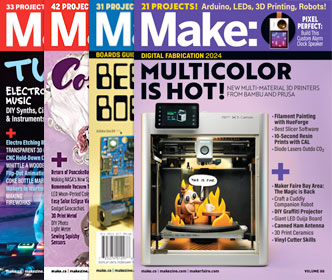PRESENTED BY


30 MINUTES
TO COMPLETE

WHAT WILL YOU MAKE?

WHAT WILL YOU NEED?
- A washed t-shirt with a large empty area
- Makey stencil PDF template
- Paper, card stock, freezer paper, or contact paper for your stencil
- A craft knife and cutting mat (optional)
- Sharp scissors
- Masking tape or straight pins
- Temporary spray adhesive (optional)
- Old newspapers or cardboard to protect surfaces
- Small spray bottles (reuse old ones from the around the house)
- Permanent markers
- Isopropyl alcohol (rubbing alcohol, 70%)
- Acrylic paint
- Paintbrushes
- Vinegar (optional)
- Glycerin (optional)
STEP 1
Prepare your stencil
Start by printing your stencil onto copy paper or cardstock. You can download a PDF of the stencil at https://bit.ly/makeystencilpdf
You may want to consider glueing your paper stencil to a heavier weight material such as a manilla folder or cardboard from a box of crackers or cereal. To make a water-proof stencil, you can tape your paper stencil to craft vinyl, contact paper, freezer paper or a thin flexible kitchen cutting sheet. A heavyweight or waterproof stencil will be easier to use.
Using either scissors or a craft knife, carefully remove the black portions of the stencil. The white portions will be the “mask”, stopping paint or marker from going through to the shirt. Be careful around the “bridges” of the stencil. These connect the “islands” to one another. Without them, the stencil will fall apart when you apply it to the shirt.
If you accidentally make a mistake and cut the wrong area, use a bit of masking tape to repair the damage.
If you have a digital craft cutter like a Cricut Maker or Silhouette Cameo, you can simply cut the stencil using the machine. You can download an SVG at https://bit.ly/makeystencilsvg
STEP 2
Attach your stencil
It is best to wash and iron your shirt before stenciling. If you don’t have time to do so, it’s ok. Just do your best to remove any stray hairs and wrinkles.
You will want to decide how you plan to hold your stencil in place. If you are using craft vinyl or contact paper, the adhesive on the back will do the work for you. If you are using paper, cardstock or cardboard, you may want to use spray adhesive or stick glue to help hold the stencil in place. If you have no way to adhere the stencil, just use masking tape or pins to hold the design in place. You don’t want the stencil to shift while you care painting or coloring.
For an adult shirt, the top of your design should sit between 2.5″ and 3″ (6-8 cm) from the bottom of the collar. If you don’t have a ruler, that’s about the width of an adult hand, fingers together, no thumb. However, different sized shirts may need adjustment.
The best way to determine the placement of your design is to simply pull out your favorite t-shirt and use it as a guide. Measure the distance from the bottom of the collar to the top of the design and use that measurement for your Maker Camp t-shirt. You may want to mark that spot with a pencil or piece of chalk.
To center your design, grab your stencil on the left and right sides. Gently, fold the stencil without creasing it. Align the fold with the tag of the shirt and lower the stencil into place. Press the stencil down and, if needed, use tape or pins to secure it.
STEP 3
Permanent Marker Tie Dye
Place a piece of cardboard or a manilla folder in between the front and back of the shirt. This will ensure that the dye from the front doesn’t stain the back of the shirt.
Use permanent markers to trace the outline of your stencil. Then fill in the shapes. If you add a lot of color, you will get more spread and less definition in the final design. If you just less marker, you will have less spread and more definition. Try using geometric shapes, crazy squiggles, and other elements rather than large blocks of solid color.
Think about what colors you place next to one another. They may bleed into one another, resulting in new colors. Have fun experimenting! You may also find that some marker colors, especially darker ones, seperate and create multiple colors when alcohol is sprayed on.
Once you are done coloring, fill a small spray bottle with isopropyl alcohol (rubbing alcohol). Take your design outside if possible. If working indoors, place the design in a large box or protect your surfaces with newspaper or plastic.
Gently spray the design with alcohol. Add a little at a time. The more alcohol you add the more the color will spread. If you accidentally add too much, try using a blow dryer or the sun to dry the area quickly.
When you’ve finished, leave the design to dry completely.
If desired, use a black marker to retrace the outline of the stencil to add definition.
Remove the stencil. Heat set the ink to the shirt by pressing it with a hot iron or placing it into the dryer on high for 20 minutes.
STEP 4
Acrylic Paint T-shirt
Acrylic paints can dry quickly and be very inflexible when they harden and “cure.” As a result, many people like to use a prepared fabric paint or mix in a fabric medium to acrylic paint before using paint on a t-shirt. However, even if you don’t have these available, you can make your own!
In a bowl or cup, combine 1 part white vinegar, 1 part vegetable glycerin and 1 part water. (I used 1 tablespoon of each, which is more than enough for a t-shirt.) Mix well.
Place your desired color of paint into a bowl or cup and add a small amount of the mixture Mix well. Take care not to thin the paint too much as it will bleed under your stencil if it is too loose. For craft acrylics, a 1:5 ratio of medium to paint is enough. For thicker art acrylics you may need to go as high as a 1:2 ratio.
To apply the paint to the shirt us a foam craft brush or other paintbrush. Use a “pouncing” motion, dabbing the paint onto the fabric rather than using paint strokes. This will reduce the chance of damaging your stencil and keep the paint from going under the stencil. Add a little at a time. You can always let it dry a bit and add more.
When you’ve achieved your desired result, carefully remove the stencil, taking care not to transfer paint from the stencil onto the shirt. Don’t let the stencil sit on the shirt for too long, It will become hard to remove as the paint dries and hardens.
Allow your shirt to cure — letting the paint bond to the fabric — for several days before washing. When you wash it, wash it inside-out to reduce the chance of transferring paint onto other clothes.
WHAT'S NEXT?
Be sure to share your creations in the Family Maker Camp Facebook Group at https://www.facebook.com/familymakercamp/.
Post and Tag @familymakercamp with the #maketogether social tag.
There are lots of other ways to make amazing Maker Camp shirts. For more ideas, check out Chapter 2 of The Big Book of Maker Camp Projects, available on Amazon, Barnes & Noble and Google Play for instant download!
Please Note
Your safety is your own responsibility, including proper use of equipment and safety gear, and determining whether you have adequate skill and experience. Power tools, electricity, and other resources used for these projects are dangerous, unless used properly and with adequate precautions, including safety gear and adult supervision. Some illustrative photos do not depict safety precautions or equipment, in order to show the project steps more clearly. Use of the instructions and suggestions found in Maker Camp is at your own risk. Make Community, LLC, disclaims all responsibility for any resulting damage, injury, or expense.
ALL DONE? SHARE IT!
Share pictures and videos of your cool build! Be sure to use #maketogether or #makercamp
POST YOUR PROJECTSKits and Books From Maker Shed
Make: produces a variety of great products and helpful project tutorials to enhance your making experience.




